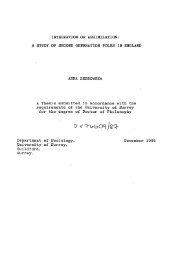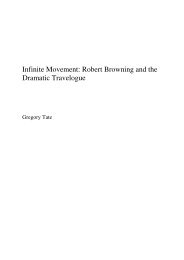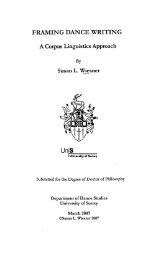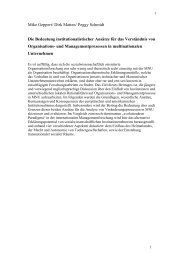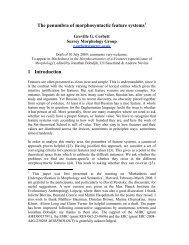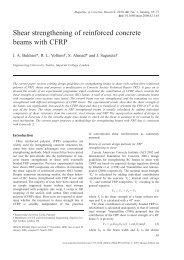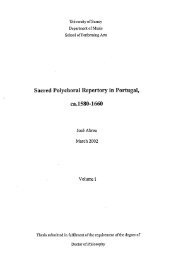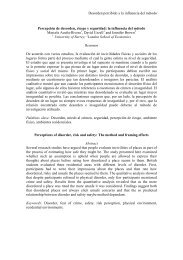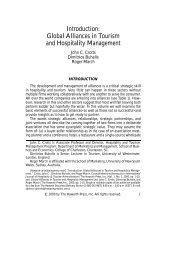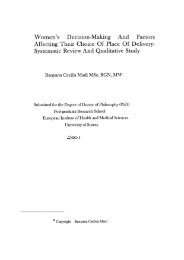Paper title - Surrey Research Insight Open Access - University of ...
Paper title - Surrey Research Insight Open Access - University of ...
Paper title - Surrey Research Insight Open Access - University of ...
You also want an ePaper? Increase the reach of your titles
YUMPU automatically turns print PDFs into web optimized ePapers that Google loves.
& DePiero 1999, Al-Emrani 1999, 2000, 2002, 2003). This type <strong>of</strong> connection, which consists<br />
<strong>of</strong> two angles riveted to each side <strong>of</strong> the stringer web and to the cross-girder web, is shown in<br />
Figure 1. The out-<strong>of</strong>-plane deformation <strong>of</strong> the connection angle and the stress concentration at<br />
the rivet head and shank junction are believed to be the most important factors that contribute<br />
towards fatigue crack initiation in these connections. The stress concentration due to the copehole<br />
also results in a fatigue critical detail (Roeder et al. 2001). Several damage cases <strong>of</strong> riveted<br />
bridges have been reported in the literature (Wyly & Scott 1956, Fisher 1984, Fisher et al. 1984,<br />
Out et al. 1984, Roeder et al. 2001).<br />
The wrought-iron bridge which is examined here was constructed in 1905 and has a single<br />
span <strong>of</strong> 9.6 m. The superstructure consists <strong>of</strong> three riveted main girders, interconnected with<br />
cross-girders and railbearers, which will be referred to as stringers for the remainder <strong>of</strong> the paper.<br />
The overall FE model and part <strong>of</strong> the mesh <strong>of</strong> the bridge are shown in Figure 2. The outer<br />
and the inner main girders are, respectively, 556x1120 mm and 668x1225 mm built-up sections,<br />
whereas cross-girders and stringers are 320x380 mm and 340x280 mm built-up sections, respectively.<br />
Flange and web thickness varies between 6.35-20.6 mm. All members are modeled using<br />
8-noded shell elements whereas the riveted connections are modeled using spring elements<br />
with variable stiffness. The bridge is considered to be simply supported, therefore, simple and<br />
roller supports are introduced to the main girders at their ends. The self-weight <strong>of</strong> the bridge and<br />
the superimposed dead load (ballast, rails, sleepers) are neglected since their effect on stress<br />
ranges is expected to be small for this bridge.<br />
The bridge is loaded with the BS 5400 (1980) Steel Train (No 1) shown in Figure 3, which is<br />
the heaviest <strong>of</strong> the BS 5400 trains. The train is traversed in steps <strong>of</strong> 1 m over one side <strong>of</strong> the<br />
bridge. No dynamic effects are taken into account since they have been found to be negligible in<br />
similar bridges (Åkesson 1994). The axle loads are applied directly to the top flange <strong>of</strong> the<br />
stringers since this has been found to be a more critical case when compared to the case <strong>of</strong> distributing<br />
the axle loads through the rail ties and ballast (Philbrick et al. 1995).<br />
The stiffness <strong>of</strong> the springs, which are used for modeling the riveted connections, is calculated<br />
based on the analytical model developed by Lee & Moon (2002). This model assumes that<br />
the connection angle is fixed at the positions <strong>of</strong> the rivets and the overall deformation <strong>of</strong> the<br />
connection is small. The elastic rotational stiffness <strong>of</strong> the connection is calculated as (Lee &<br />
Moon 2002)<br />
2EI<br />
⎛ g + g ⎞<br />
= (1)<br />
1 2 3<br />
K l<br />
3<br />
a<br />
g g 1 1 4g<br />
⎟<br />
2<br />
⎟<br />
⎜<br />
⎝ + ⎠<br />
where EI = bending stiffness <strong>of</strong> the angle segment per unit length; la = angle length; and<br />
g1, g2 = grip lengths on each angle leg. An angle length <strong>of</strong> 260 mm, angle thickness <strong>of</strong> 12.6 mm<br />
and grip values <strong>of</strong> 40 mm are used in Equation 1. Three cases are examined on the basis <strong>of</strong> assuming<br />
different connection rotational stiffnesses. The first case assumes fully fixed connections<br />
(infinite stiffness) and is modeled by tying the various members to each other. For the second<br />
case, the connections are assumed to possess a rotational stiffness K given by Equation 1. In<br />
this case, an effective angle length la corresponding to the full angle length is used assuming a<br />
high clamping force in the rivets. This rotational stiffness value is, then, transformed into a set<br />
<strong>of</strong> translation springs stiffnesses by assuming plane sections remain plane. A total <strong>of</strong> 18 springs<br />
are used for the cross-girder-to-main girder connections and a total <strong>of</strong> 12 springs are used for the<br />
stringer-to-cross-girder connections. In the third case, corresponding to a reduced clamping<br />
force, a lower effective angle length la (diameter <strong>of</strong> rivet head × number <strong>of</strong> rivets) is used (Lee<br />
& Moon 2002). A rivet diameter <strong>of</strong> 19 mm is considered. This results in a reduced stiffness <strong>of</strong><br />
K/40 for the cross-girder-to-main girder connections and K/13 for the stringer-to-cross-girder<br />
connections. The different stiffness values are due to the different angle lengths used.<br />
The damage caused by the passage <strong>of</strong> a single train (Fig. 3) is calculated by using the rainflow<br />
counting method (Downing & Socie 1982) and Miner’s Rule (Miner 1945). To this end,<br />
the BS 5400 (1980) two slope S-N curve is used. Thickness effects are not considered since the<br />
largest thickness <strong>of</strong> the bridge elements is marginally higher than 16 mm (BS 7608 1993). The<br />
connection details are classified either as Class B with the appropriate stress concentration fac-




